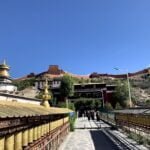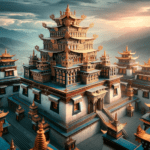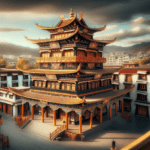Discover Keru Lhakang: A Hidden Gem of Tibetan Heritage in Nedong County
Keru Lhakang: An Ancient Testament to the Tubo Period
Located in the charming village of Keru in Kalsang Township, Nedong County. (བྲག་དམར་ཀེ་རུ་ལྷ་ཁང) Drakmar Keru Lhakang,” stands as a rich historical testament to the Tubo period. Despite its modest size, Keru Lhakang is a repository of ancient Tibetan architecture, sculptures, clay statues, and murals, offering invaluable insights into Tibet’s history, religion, and art. It gained national recognition as a key cultural relic, officially designated by the State Council on June 25, 2001.

A Journey Through Time: Architectural Evolution of Keru Lhakang
Tracing back to the 8th century and the reign of Tride Tsuktsen, Keru Lhakang covers an area of 982 square meters. Oriented with its main façade facing east, the temple is one of Tibet’s oldest surviving structures.
The architecture of Keru Lhakang is divided into five distinct historical phases:
- First Phase: Namna Lakang, belonging to the early to mid-Tubo period.
- Second Phase: The Shakya Buddha Hall and prayer wheel corridor, originally built in the early 8th century. The existing temple structure expanded upon this foundation.
- Third Phase: Gaden Chokor Lakang, dating back to the early 11th century, once a residence of Atiśa Dipamkara.
- Fourth Phase: The assembly hall, along with adjacent prayer wheel corridors and monks’ quarters, constructed between the 16th and 17th centuries.
- Fifth Phase: A series of smaller buildings added during a 1957 expansion.
The temple’s layout consists of two primary sections: the southern part, the temple’s main body, includes the Shakya Buddha Hall, assembly hall, and prayer wheel corridor; the northern side features Namna Lakang and Gaden Chokor Lakang.
Keru Lhakang is not merely a religious site but a living museum, encapsulating the essence of Tibetan cultural and architectural evolution. Visiting this ancient temple offers a unique opportunity to step back in time and immerse in Tibet’s spiritual and historical richness.
Discover Keru Lhakang: A Treasure of Tibetan Art and History
Architectural Marvel of Keru Lhakang: The Shakya Buddha Hall
At the heart of Keru Lhakang lies the Shakya Buddha Hall, a prime example of Tibetan architecture. The hall, measuring 8.8 meters in width, 7.7 meters in depth, and 6.5 meters in height, encompasses approximately 65 square meters. Surrounded by thick stone walls, it exhibits a rustic and robust construction with heavy beams and columns.
Vibrant Artistry in the Buddha Hall
The Shakya Buddha Hall’s columns are adorned with dynamic sculptures of lions, tigers, and dragons, characterized by vivid, fluid lines. These lively carvings, full of rhythm and movement, offer a window into ancient Tibetan artistry.
Sacred Texts and Clay Sculptures
Keru Lhakang houses precious artifacts from the Tubo period, including palm-leaf scriptures and birch bark scrolls. The Buddha Hall contains 13 exquisitely crafted clay statues, including a 3.2-meter-tall Shakyamuni Buddha accompanied by his disciples, guardian figures, and patrons, symbolizing the temple’s spiritual and artistic importance.
Exquisite Thangka of Avalokiteshvara
A unique feature of Keru Lhakang’s collection is an Avalokiteshvara thangka, 80 cm by 23.6 cm. This intricate artwork portrays Avalokiteshvara in elaborate detail, with a smaller frame depicting patrons, enhancing the thangka’s complexity. The backside features 54 lines of Sanskrit transliterated into Tibetan.
Visiting Tips
- Getting There: Accessible from Tsedang, cross the Niangpu Bridge into the Wendi area and travel 7 kilometers to reach Keru Lhakang.
- Unique Attractions: The temple’s interior boasts ancient medicinal clay statues and over 200 volumes of handwritten Buddhist scriptures, underscoring its historical and research significance.
Keru Lhakang is more than a temple; it is a living testament to Tibetan history and art. Its architectural splendor, ancient scriptures, and vibrant thangkas provide a unique glimpse into the rich cultural heritage of Tibet.















